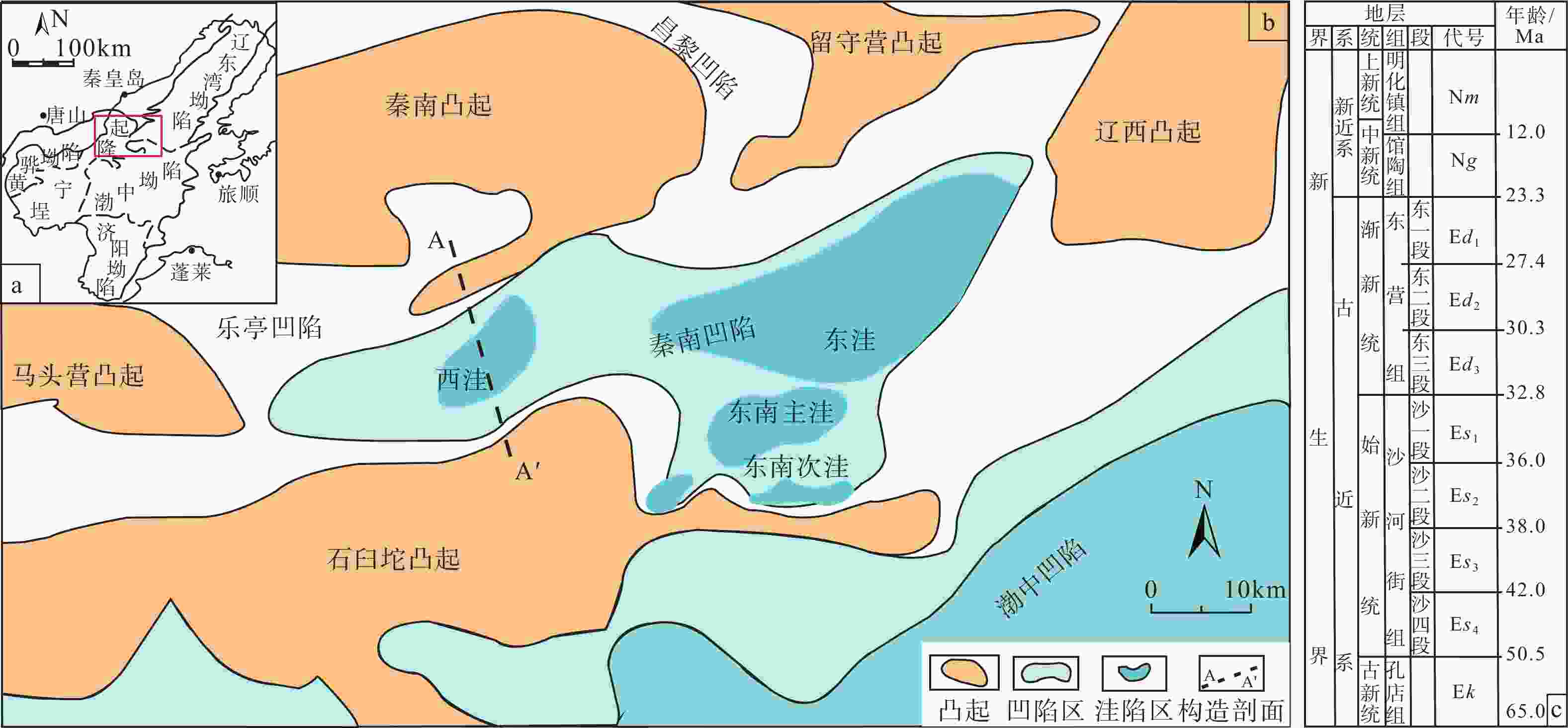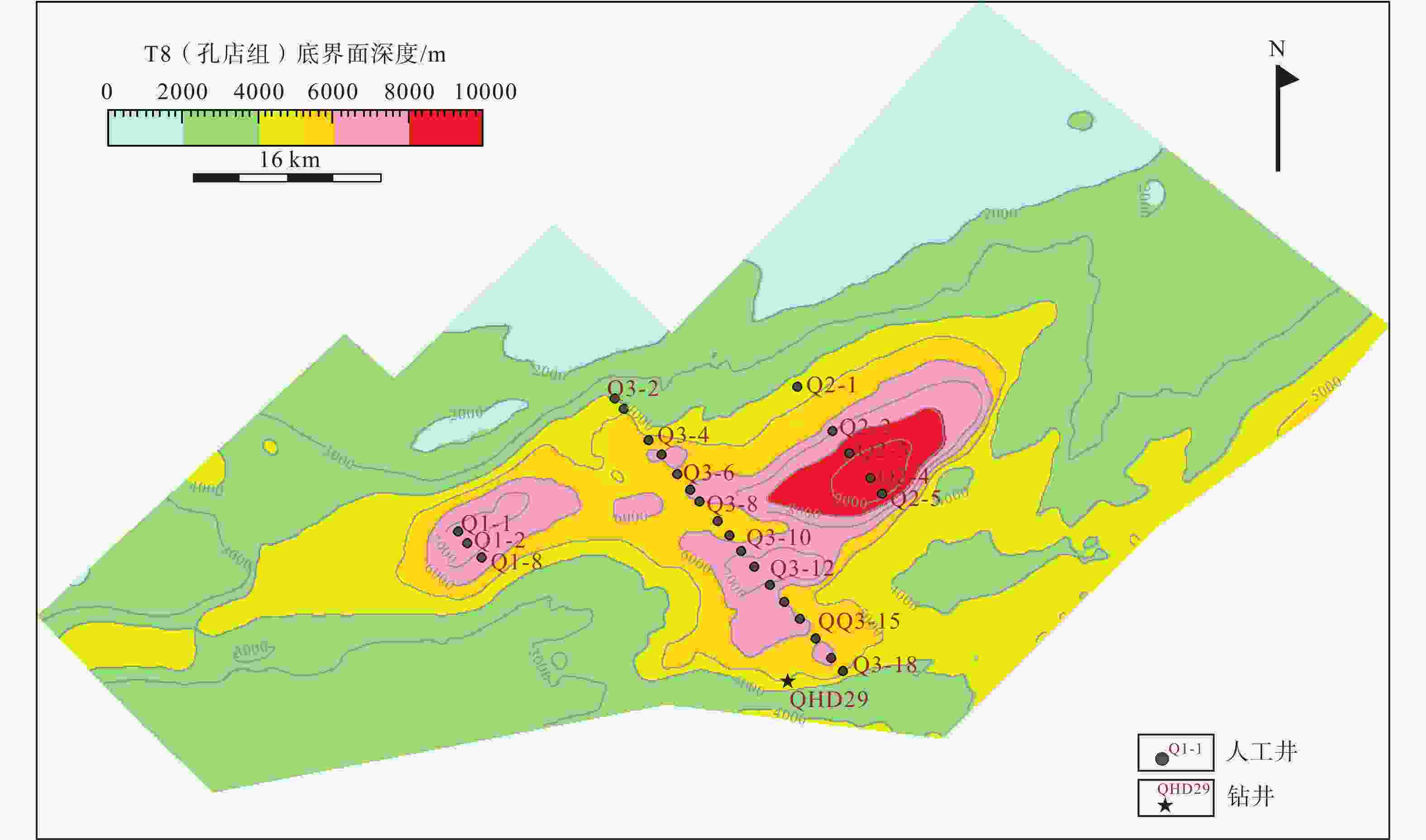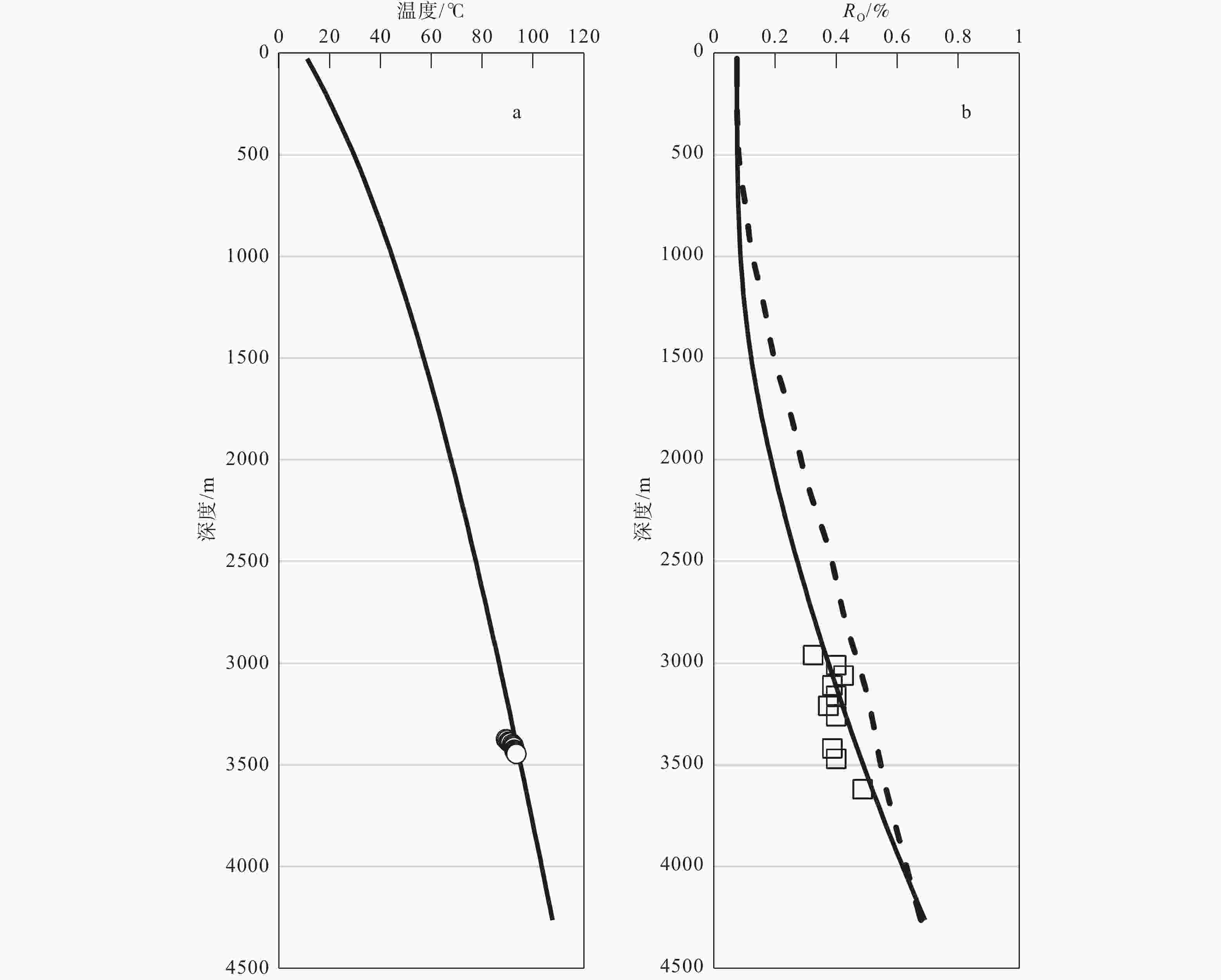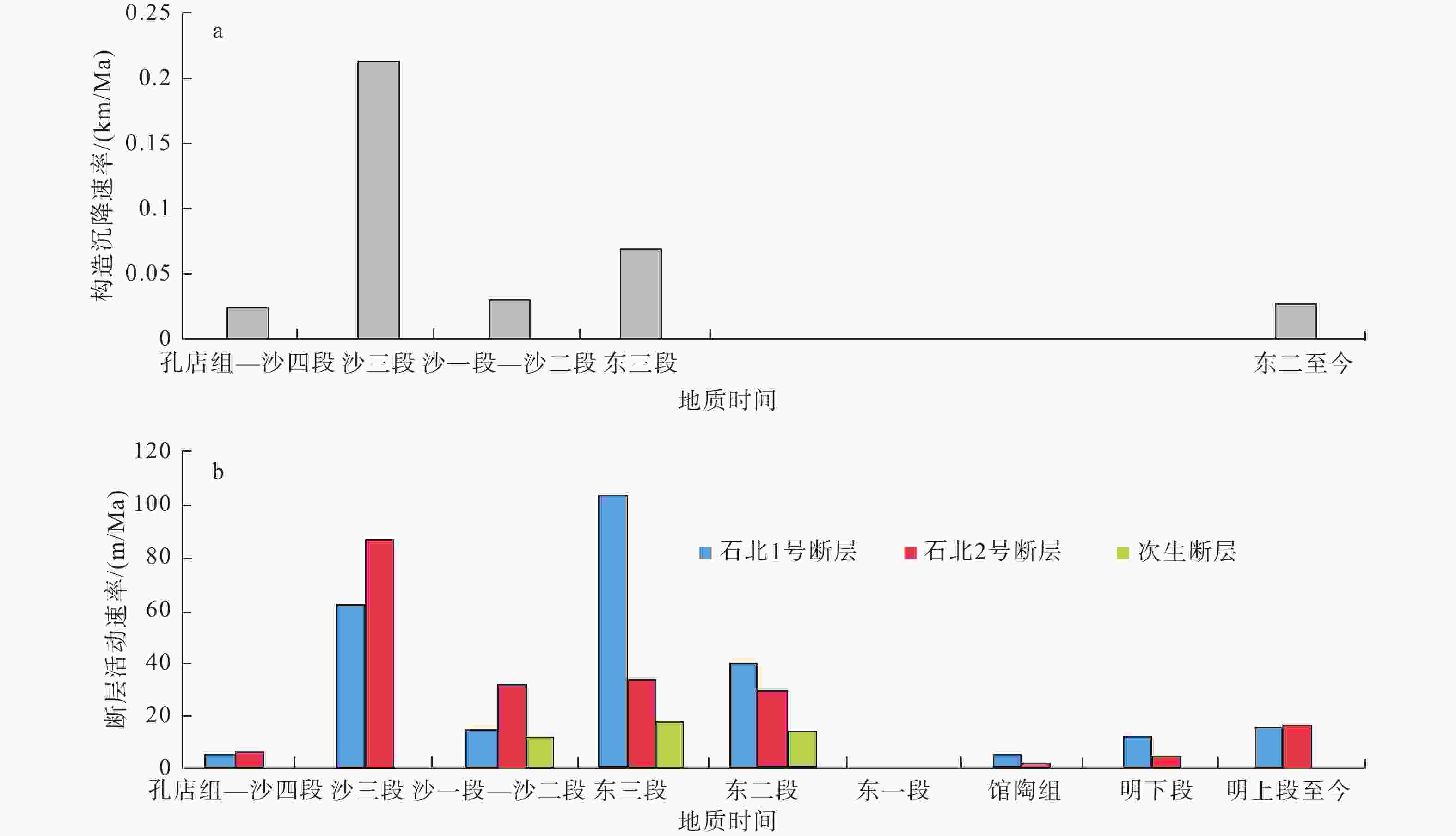Cenozoic tectonic-thermal history reconstruction of the Qinnan Depression, Bohai Basin
-
摘要: 构造−热演化史是认识盆地形成及其动力学机制的重要窗口,也是烃源岩成熟生烃研究的核心问题。随着能源需求的增长以及陆地油气发现难度的增加,海域逐渐成为中国油气勘探的重要接替区与国家能源战略研究的重要领域。秦南凹陷位于渤海海域西北部,勘探前景良好,但勘探程度低,构造−热演化研究尚属空白。文章选取秦南凹陷3条地震剖面,建立25口人工井,进行了构造沉降史和热史模拟,恢复了秦南凹陷构造−热演化历史。研究结果表明:秦南凹陷新生代以来于孔店组—沙河街组四段沉积时期(65~42 Ma)、沙河街组三段沉积时期(42~38 Ma)以及东营组三段沉积时期(32.8~30.3 Ma)分别经历了3期裂陷拉张,总拉张系数为1.27~2.05;对应这3期拉张作用,秦南凹陷基底热流经历3期升高,在东营组三段沉积末期(30.3 Ma)基底热流达到峰值64.0~89.0 mW/m2,之后逐渐降低至今;秦南凹陷构造−热演化过程与断裂活动具有良好的耦合关系。研究获得的拉张系数、基底热流等参数对于了解渤海盆地构造演化的深部动力学机制以及指导研究区油气勘探具有重要意义。Abstract:
Objective Tectono-thermal history is important to understand basin evolution and its geodynamic mechanism and is the key question to be solved for source rock maturation study. With the increasing energy demand and difficulty in oil and gas discovery on land, sea basins have gradually become an important alternative for oil and gas exploration and a hotspot of national energy strategy research. The Qinnan Depression, located in the northwest of the Bohai Sea, has good exploration prospects. However, owing to the low level of exploration, research on the tectono-thermal evolution of Qinnan Depression is still limited. Methods In this study, 25 artificial wells have been established based on 3 seismic profiles of the Qinnan Depression, and their tectonic subsidence and thermal history have been modeled to reconstruct the tectonic-thermal evolution history using a multi-stage finite stretching model. Results The results indicate that since the Cenozoic era, the Qinnan Depression has undergone three stages of rifting and stretching during the sedimentary periods of the Kongdian Formation to fourth member of the Shahejie Formation (65–42 Ma), the third member of the Shahejie Formation (42–38 Ma), and the third member of the Dongying Formation (32.8–30.3 Ma), with a total stretching factor of 1.27–2.05. Corresponding to the three stages of stretching, the basal heat flow of the Qinnan Depression has experienced three stages of increase, reaching a peak of 64.0–89.0 mW/m2 at the end of the deposition of the third member of the Dongying Formation (~30.3 Ma), and then decreased gradually until present. Conclusion The Qinnan Depression underwent three phases of heating and two stages of cooling since the Cenozoic period. There is a good coupling relationship between the tectonic-thermal evolution process and fault activity in the Qinnan Depression. Significance The parameters such as tension system and basement heat flow history obtained in this study are of great significance for understanding the deep dynamic mechanisms of basin tectonic evolution and guiding oil and gas exploration. -
Key words:
- Bohai Basin /
- Qinnan Depression /
- structure subsidence /
- thermal history /
- Cainozoic
-
图 2 秦南凹陷构造剖面图(剖面位置见图1b;据胡志伟等,2019修改)
注:Mz—基底;Qp—更新统;其他地层符号同图1c
Figure 2. Structural section of the Qinnan Depression (The cross-sectional position is shown in Fig.1b;modified from Hu et al., 2019)
Notes: Mz—basement; Qp—Pleistocene; other stratigraphic symbols are the same as Fig.1c.
图 5 渤海盆地秦南凹陷观测构造沉降曲线与预测沉积曲线拟合
β—总拉张因子
Figure 5. Subsidence analysis for the 25 artificial wells in the Qinnan depression.
The circles connected by the dashed lines indicate observed subsidence (from back-stripping), while the dark solid lines represent the theoretical subsidence predicted by the multi-episodic finite stretching model; β—total stretching factor.
图 7 模拟温度及镜质体反射率与实测值拟合图
a—温度模拟值与实测值(实线为模拟得到的温度曲线,圆圈为实测的温度值);b—镜质体反射率模拟值与实测值(实线为ARCO模型计算而得的RO曲线,虚线为LLNL模型计算而得的RO曲线,方框为实测RO)
Figure 7. Simulated and measured values of temperature and vitrinite reflectance
(a) Simulated and measured values of temperature (the solid line represents the simulated temperature curve, and the circle represents the measured temperature value); (b) Simulated and measured values of vitrinite reflectance (the solid line represents the RO value curve calculated by the ARCO model, the dashed line represents the RO value curve calculated by the LLNL model, and the box represents the measured RO value)
图 8 秦南凹陷各沉积时期平均构造沉降速率与断层平均活动速率
a—平均构造沉降速率;b—断层平均活动速率(刘丹丹等,2020)
Figure 8. Average tectonic subsidence rate and fault activity rate during different sedimentary periods in the Qinnan Depression
(a) Average tectonic subsidence rate; (b) Average fault activity rate(Liu et al.,2020)
表 1 模型参数及取值
Table 1. Definitions and values of parameters used in this study
参数符号 参数名称 取值 单位 $ a $ 岩石圈厚度 125 km $ {t}_{{\mathrm{c}}} $ 初始地壳厚度 35 km $ {\rho }_{{\mathrm{w}}} $ 海水密度 1030 kg/m3 $ {\rho }_{{\mathrm{c}}} $ 地壳密度 2800 kg/m3 $ {\rho }_{{\mathrm{m}}} $ 地幔密度 3330 kg/m3 $ {\rho }_{{\mathrm{a}}} $ 软流圈密度 3200 kg/m3 $ \mathrm{\kappa } $ 岩石圈热扩散率系数 1.0×10−6 m2/s $ \mathrm{\alpha } $ 岩石圈热膨胀系数 3.2×10−5 ℃−1 $ {K}_{{\mathrm{c}}} $ 地壳热导率 3.1 W/(m·K) $ {K}_{{\mathrm{m}}} $ 地幔热导率 2.9 W/(m·K) 注:模型参数取值参考刘琼颖和何丽娟(2019)、Chen(2014) 表 2 渤海盆地秦南凹陷拉张因子
Table 2. Stretching factors of the Qinnan Depression
洼陷 井号 第1期
(65~42 Ma)第2期
(42~38 Ma)第3期
(32.8~30.3Ma)总拉张
因子西洼 Q1-1 1.05 1.16 1.04 1.27 Q1-2 1.07 1.24 1.01 1.34 Q1-8 1.41 1.09 1.01 1.55 东洼 Q2-1 1.04 1.28 1.08 1.44 Q2-2 1.11 1.37 1.08 1.64 Q2-3 1.19 1.43 1.08 1.84 Q2-4 1.14 1.62 1.11 2.05 Q2-5 1.10 1.51 1.18 1.96 东南洼 Q3-2 1.13 1.14 1.04 1.34 Q3-3 1.01 1.54 1.02 1.59 Q3-4 1.05 1.49 1.03 1.61 Q3-5 1.13 1.37 1.03 1.59 Q3-6 1.10 1.36 1.05 1.57 Q3-7 1.10 1.33 1.07 1.57 Q3-8 1.09 1.32 1.08 1.55 Q3-9 1.18 1.16 1.08 1.48 Q3-10 1.18 1.21 1.05 1.50 Q3-11 1.32 1.18 1.03 1.60 Q3-12 1.23 1.35 1.04 1.73 Q3-13 1.24 1.20 1.09 1.62 Q3-14 1.15 1.21 1.10 1.53 Q3-15 1.16 1.28 1.03 1.53 Q3-16 1.15 1.25 1.06 1.52 Q3-17 1.18 1.19 1.07 1.50 Q3-18 1.13 1.19 1.07 1.44 平均值 1.15 1.30 1.06 1.57 表 3 渤海盆地秦南凹陷人工井基底热流史(单位:mW/m2)
Table 3. Calculated basal heat flow data for all the artificial wells in Qinnan Depression
洼陷 井名 65Ma 42Ma 38Ma 32.8Ma 30.3Ma 23.3Ma 12Ma 0Ma 西洼 Q1-1 54.9 56.6 62.4 62.4 64.0 63.7 62.7 61.4 Q1-2 54.9 57.3 66.2 66.0 66.4 65.9 64.5 62.7 Q1-8 54.9 68.9 72.8 71.9 71.9 70.2 67.4 64.8 平均值 60.9 67.1 66.8 67.4 63.0 东洼 Q2-1 54.9 56.3 66.4 66.3 69.9 69.3 67.5 65.2 Q2-2 54.9 58.7 72.8 72.5 76.3 74.9 71.7 68.3 Q2-3 54.9 61.4 78.9 78.1 82.0 79.5 74.9 70.6 Q2-4 54.9 59.7 83.9 83.0 89.0 85.4 79.2 73.7 Q2-5 54.9 58.3 77.7 77.2 86.9 84.0 78.4 73.2 平均值 58.9 75.9 75.4 80.8 70.2 东南洼 Q3-2 54.9 59.4 64.8 64.6 66.2 65.6 64.1 62.4 Q3-3 54.9 55.2 74.1 74.1 75.0 74.1 71.2 68.0 Q3-4 54.9 56.6 74.4 74.2 75.6 74.4 71.4 68.1 Q3-5 54.9 59.4 73.8 73.3 74.6 73.2 70.3 67.2 Q3-6 54.9 58.3 72.0 71.7 74.0 72.8 70.1 67.1 Q3-7 54.9 58.3 70.9 70.6 73.9 72.7 70.0 67.0 Q3-8 54.9 58.0 70.0 69.8 73.5 72.5 69.9 66.9 Q3-9 54.9 61.1 67.5 67.2 70.7 69.6 67.4 64.9 Q3-10 54.9 61.1 69.6 69.1 71.3 70.1 67.8 65.2 Q3-11 54.9 65.9 73.7 72.9 73.9 72.2 69.1 66.2 Q3-12 54.9 62.8 77.4 76.6 78.2 76.1 72.3 68.6 Q3-13 54.9 63.1 71.5 70.9 75.0 73.4 70.3 67.1 Q3-14 54.9 60.1 68.3 68.0 72.5 71.4 68.9 66.2 Q3-15 54.9 60.4 71.5 71.1 72.3 71.1 68.5 65.8 Q3-16 54.9 60.1 69.9 69.6 72.2 71.1 68.6 65.9 Q3-17 54.9 61.1 68.7 68.3 71.4 70.3 67.9 65.4 Q3-18 54.9 59.4 66.8 66.5 69.5 68.7 66.7 64.5 平均值 60.2 69.0 68.7 71.6 65.6 -
[1] CAI S W, ZHANG X T, ZHANG J S, et al., 2018. Analysis of velocity anomalies of the Qa structure in the BZ1 exploration area, Bozhong sag[J]. Earth Science Frontiers, 25(4): 168-175. (in Chinese with English abstract [2] CHANG J, QIU N S, ZHAO X Z, et al., 2018. Mesozoic and Cenozoic tectono-thermal reconstruction of the western Bohai Bay Basin (East China) with implications for hydrocarbon generation and migration[J]. Journal of Asian Earth Sciences, 160: 380-395. doi: 10.1016/j.jseaes.2017.09.008 [3] CHANG T T, ZHANG Z, WANG W H, et al.,2022. Hydrocarbon Accumulation Conditions and Models of the Hari Sag in the Yingen-Ejinaqi Basin[J]. Geology and Exploration,58(4):905-917. (in Chinese with English abstract [4] CHEN L, 2014. Stretching factor estimation for the long-duration and multi-stage continental extensional tectonics: application to the Baiyun Sag in the northern margin of the South China Sea[J]. Tectonophysics, 611: 167-180. doi: 10.1016/j.tecto.2013.11.026 [5] HAO T Y, YOU Q Y, LIU L H, et al., 2013. Joint land-sea seismic survey and research on the deep structures of the Bohai sea areas[J]. Acta Oceanologica Sinica, 32(12): 13-24. doi: 10.1007/s13131-013-0383-4 [6] HE L J, WANG J Y, 2007. Tectono-thermal modeling of sedimentary basins: review and outlook[J]. Progress in Geophysics, 22(4): 1215-1219. (in Chinese with English abstract [7] HU J, LONG Z L, HUANG Y P, et al., 2021. Tectono-thermal modelling of Baiyun Sag, Pearl River Mouth Basin, since Cenozoic[J]. Chinese Journal of Geophysics, 64(5): 1654-1665. (in Chinese with English abstract [8] HU S B, ZHANG R Y, LUO Y H, et al., 1999. Thermal history and tectonic-thermal evolution of BoHai basin, East China[J]. Chinese Journal of Geophysics, 42(6): 748-755. (in Chinese with English abstract [9] HU S B, O'SULLIVAN P B, RAZA A, et al., 2001. Thermal history and tectonic subsidence of the Bohai Basin, northern China: a Cenozoic rifted and local pull-apart basin[J]. Physics of the Earth and Planetary Interiors, 126(3-4): 221-235. doi: 10.1016/S0031-9201(01)00257-6 [10] HU Z W, WANG D Y, NIU C M, et al., 2019. Characteristics of fault system and evaluation of hydrocarbon generation potential in western Liaoxi-Qinnan area, China[J]. Journal of Chengdu University of Technology (Science & Technology Edition), 46(5): 618-627. (in Chinese with English abstract [11] HUANG J L, ZHAO D P, 2006. High-resolution mantle tomography of China and surrounding regions[J]. Journal of Geophysical Research: Solid Earth, 111(B9): B09305. [12] HUANG Z X, XU Y, HAO T Y, et al., 2009. Surface wave tomography of lithospheric structure in the seas of east China[J]. Chinese Journal of Geophysics, 52(3): 653-662. (in Chinese with English abstract [13] JARVIS G T, MCKENZIE D P, 1980. Sedimentary basin formation with finite extension rates[J]. Earth and Planetary Science Letters, 48(1): 42-52. doi: 10.1016/0012-821X(80)90168-5 [14] JIANG D D, JIANG W W, HU W J, 2013. Study of crustal structure and geodynamic characteristics around the Bohai Sea area[J]. Progress in Geophysics, 28(4): 1729-1738. (in Chinese with English abstract [15] JIANG S, ZUO Y H, YANG M H, et al., 2021. Reconstruction of the Cenozoic tectono-thermal history of the Dongpu Depression, Bohai Bay Basin, China: constraints from apatite fission track and vitrinite reflectance data[J]. Journal of Petroleum Science and Engineering, 205: 108809. doi: 10.1016/j.petrol.2021.108809 [16] KANG H L, LIN C S, NIU C M, 2021. Ancient landform of the Dongying formation in the Shadongnan structural zone, western Bohai Sea area and its control on the sedimentation[J]. Journal of Geomechanics, 27(1): 19-30. (in Chinese with English abstract [17] LAI W C, XU C G, WANG X G, et al., 2007. A study on Paleogene sequence stratigraphy and Sedimentary systems and a discussion on hydrocarbon Exploration directions in Qinnan depression[J]. China Offshore Oil and Gas, 19(5): 300-305. (in Chinese with English abstract [18] LI S Z, XU S M, SHAN Y H, 2000. Basin assemblages and tectonic evolution in the Bohai Gulf and its neighbors[J]. Acta Oceanologica Sinica, 19(4): 91-105. [19] LIU D D, ZHANG X F, ZHOU Y Y, et al., 2020. Fault activities on the southeastern margin of the qinnan sag in the BoHai sea and their control over paleogene hydrocarbon accumulations[J]. Marine Geology Frontiers, 36(4): 45-54. (in Chinese with English abstract [20] LIU Q Y, HE L J, 2019. Tectono-thermal modeling of the BoHai Bay Basin since the cenozoic[J]. Chinese Journal of Geophysics, 62(1): 219-235. (in Chinese with English abstract [21] LIU Q Y, HE L J, CHEN L C, 2018. Tectono-thermal modeling of Cenozoic multiple rift episodes in the Bohai Bay Basin, eastern China and its geodynamic implications[J]. International Journal of Earth Sciences, 107(1): 53-69. doi: 10.1007/s00531-017-1550-1 [22] NIU C M, WANG F L, TANG G M, et al., 2018. Evaporative fractionation and biodegradation impacts on a complex petroleum system: QHD29-2 oil field, Bohai Sea area[J]. Petroleum Geology & Experiment, 40(3): 381-388. (in Chinese with English abstract [23] PANG X J, WANG Q B, DAI L M, et al., 2017. Paleogene fault activities and their control over sedimentation at southeastern margin of Qinnan Sag, northern Bohai Sea[J]. Oil & Gas Geology, 38(6): 1059-1067. (in Chinese with English abstract [24] PENG B, ZOU H Y, 2013. Present-day geothermal structure of lithosphere and the Cenozoic Tectono-thermal evolution of Bohai basin[J]. Geoscience, 27(6): 1399-1406. (in Chinese with English abstract [25] QIU N S, ZUO Y H, CHANG J, et al., 2014. Geothermal evidence of Meso-Cenozoic lithosphere thinning in the Jiyang sub-basin, Bohai Bay Basin, eastern North China Craton[J]. Gondwana Research, 26(3-4): 1079-1092. doi: 10.1016/j.gr.2013.08.011 [26] REN Z L, LIU L, CUI J P, et al., 2008. Application of tectonic-thermal evolution history to hydrocarbon accumulation timing in sedimentary basins[J]. Oil & Gas Geology, 29(4): 502-506. (in Chinese with English abstract [27] RODON S, LITTKE R, 2005. Thermal maturity in the Central European Basin system (Schleswig-Holstein area): results of 1D basin modelling and new maturity maps[J]. International Journal of Earth Sciences, 94(5-6): 815-833. doi: 10.1007/s00531-005-0006-1 [28] SCLATER J G, CHRISTIE P A F, 1980. Continental stretching: an explanation of the post-Mid-Cretaceous subsidence of the central North Sea Basin[J]. Journal of Geophysical Research: Solid Earth, 85(B7): 3711-3739. doi: 10.1029/JB085iB07p03711 [29] SHI W L, LI H Y, MAO L, et al., 2014. Hydrocarbon geological characteristics and exploration potential of Qinnan depression in offshore area of Bohai sea[J]. China Petroleum Exploration, 19(5): 32-40. (in Chinese with English abstract [30] TANG X Y, CHEN L, HU S B, et al., 2014a. Tectono-thermal evolution of the Reed Bank Basin, Southern South China Sea[J]. Journal of Asian Earth Sciences, 96: 344-352. doi: 10.1016/j.jseaes.2014.09.030 [31] TANG X Y, YANG S C, HU S B, 2014b. Thermal and maturation history of Jurassic source rocks in the Kuqa foreland depression of Tarim Basin, NW China[J]. Journal of Asian Earth Sciences, 89: 1-9. doi: 10.1016/j.jseaes.2014.03.023 [32] TANG X Y, ZUO Y H, KOHN B, et al., 2019. Cenozoic thermal history reconstruction of the Dongpu Sag, Bohai Bay Basin: insights from apatite fission-track thermochronology[J]. Terra Nova, 31(3): 159-168. doi: 10.1111/ter.12379 [33] TANG X Y, YANG S C, HU S B, 2023. Tectonic-thermal history and hydrocarbon potential of the Pearl River Mouth Basin, northern South China Sea: insights from borehole apatite fission-track thermochronology[J]. China Geology, 6(3): 429-442. [34] TANG X Y, ZHONG C, YANG S C, et al., 2023. Characteristics and influence factors of the present geothermal field for basins in China’s offshore and adjacent areas[J]. Acta Geologica Sinica, 97(3): 911-921. (in Chinese with English abstract doi: 10.1111/1755-6724.15061 [35] WANG D Y, YU H B, WANG J, et al., 2015. Key exploration techniques for stratigraphic-lithologic reservoirs and their application in Qinnan sag, Bohai sea[J]. China Offshore Oil and Gas, 27(3): 16-24. (in Chinese with English abstract [36] WANG G M, ZHANG J, WANG Q B, et al., 2018. Factors controlling medium-to-deep coarse siliciclastic reservoirs of high quality at the southeastern margin of Qinnan Sag, BoHai Bay Basin, China[J]. Oil & Gas Geology, 39(2): 330-339. (in Chinese with English abstract [37] XIE X N, CUI T, DIETMAR M R, et al., 2007. Subsidence history and forming mechanism of anomalous tectonic subsidence in the Bozhong depression, Bohaiwan basin[J]. Science in China Series D: Earth Sciences, 50(9): 1310-1318. doi: 10.1007/s11430-007-0095-8 [38] XIE Y H, ZHANG G C, SHEN P, et al., 2018. Formation conditions and exploration direction of large gas field in Bozhong sag of Bohai Bay Basin[J]. Acta Petrolei Sinica, 39(11): 1199-1210. (in Chinese with English abstract [39] XIN Y F, GUO X W, WEN Z H, et al., 2015. Cenozoic shallow tectonic migration and the deep dynamic mechanism in the Bohai Sea[J]. Progress in Geophysics, 30(4): 1535-1543. (in Chinese with English abstract [40] XING Z Y, XING J S, ZHAO B, 2006. Deep-seated structure of North China[J]. Geological Science and Technology Information, 25(6): 17-23, 36. (in Chinese with English abstract [41] XU C G, ZHOU X H, DENG J H, 2010. Discovery of large-scale Jinzhou 25-1 light oil & gas field in Bohai Sea area and its enlightenment[J]. China Petroleum Exploration, 15(1): 34-38. (in Chinese with English abstract [42] YANG C C, GUO R, WANG F M, et al., 2019. Quantitative prediction of TOC in source rocks of the Member 3 of Shahejie Formation in Qinnan Depression, Bohai Sea, China[J]. Journal of Chengdu University of Technology (Science & Technology Edition), 46(5): 549-557. (in Chinese with English abstract [43] ZHANG C K, ZHANG X K, ZHAO J R, et al., 2002. Study and review on crust-mantle velocity structure in Bohai Bay and its adjacent areas[J]. Acta Seismologica Sinica, 24(4): 428-435. (in Chinese with English abstract [44] ZHANG Y Y, WU T, GOU W,2023. Reservoir Characteristics and Hydrocarbon Accumulation Models of the Bach Ho Oilfield in Cuu Long Basin, Vietnam[J]. Geology and Exploration,59(1):170-187. (in Chinese with English abstract [45] ZHAO Z B, HOU D J, CHENG X, et al., 2018. A fitting prediction method of TOC in source rocks in a marginal sag: a case study of northeastern sag in Laizhou Bay, Bohai Bay Basin[J]. Oil Geophysical Prospecting, 53(2): 347-354. (in Chinese with English abstract [46] ZHENG H W, GENG S F, YANG G, et al., 2012. Deep structure beneath eastern China from teleseismic P-wave tomography[J]. Geological Bulletin of China, 31(7): 1069-1077. (in Chinese with English abstract [47] ZHUANG X B, ZOU H Y, LI N, et al., 2011. Origin of natural gas and exploration potential of hydrocarbon, Qinnan area[J]. Journal of Jilin University (Earth Science Edition), 41(3): 680-688. (in Chinese with English abstract [48] ZUO Y H, QIU N S, HAO Q Q, et al., 2015. Geothermal regime and source rock thermal evolution in the Chagan sag, Inner Mongolia, northern China[J]. Marine and Petroleum Geology, 59(0): 245-267. [49] ZUO Y H, YE B, WU W T et al. , 2017. Present temperature field and Cenozoic thermal history in the Dongpu depression, Bohai Bay Basin, North China[J]. Marine and Petroleum Geology, 88(Supplement C): 696-711. [50] 蔡少武,张新涛,张京思,等,2018. 渤中凹陷BZ1探区Qa构造速度异常分析[J]. 地学前缘,25(4):168-175. [51] 常甜甜, 张征, 王文慧, 等,2022. 银额盆地哈日凹陷油气成藏条件及模式[J]. 地质与勘探,58(4):905-917 [52] 何丽娟,汪集旸,2007. 沉积盆地构造热演化研究进展:回顾与展望[J]. 地球物理学进展,22(4):1215-1219. doi: 10.3969/j.issn.1004-2903.2007.04.029 [53] 胡杰,龙祖烈,黄玉平,等,2021. 珠江口盆地白云凹陷新生代构造-热演化模拟[J]. 地球物理学报,64(5):1654-1665. [54] 胡圣标,张容燕,罗毓晖,等,1999. 渤海盆地热历史及构造-热演化特征[J]. 地球物理学报,42(6):748-755. doi: 10.3321/j.issn:0001-5733.1999.06.004 [55] 胡志伟,王德英,牛成民,等,2019. 辽西—秦南地区断裂体系形成与演化特征[J]. 成都理工大学学报(自然科学版),46(5):618-627. doi: 10.3969/j.issn.1671-9727.2019.05.12 [56] 黄忠贤,胥颐,郝天珧,等,2009. 中国东部海域岩石圈结构面波层析成像[J]. 地球物理学报,52(3):653-662. [57] 姜迪迪,江为为,胡卫剑,2013. 环渤海地区地壳结构及其动力学特征研究[J]. 地球物理学进展,28(4):1729-1738. doi: 10.6038/pg20130413 [58] 康海亮,林畅松,牛成民,2021. 渤海西部沙东南构造带东营组古地貌特征及对沉积的控制作用[J]. 地质力学学报,27(1):19-30. doi: 10.12090/j.issn.1006-6616.2021.27.01.003 [59] 赖维成,徐长贵,王晓刚,等,2007. 秦南凹陷古近系层序地层和沉积体系研究及油气勘探方向探讨[J]. 中国海上油气,19(5):300-305. doi: 10.3969/j.issn.1673-1506.2007.05.003 [60] 刘丹丹,张雪芳,周园园,等,2020. 渤海海域秦南凹陷东南缘断层活动对古近系油气富集的控制[J]. 海洋地质前沿,36(4):45-54. [61] 刘琼颖,何丽娟,2019. 渤海湾盆地新生代以来构造-热演化模拟研究[J]. 地球物理学报,62(1):219-235. doi: 10.6038/cjg2019M0637 [62] 牛成民,王飞龙,汤国民,等,2018. 复合油藏形成中的蒸发分馏与生物降解联合控制作用:以渤海海域秦皇岛29-2油田为例[J]. 石油实验地质,40(3):381-388. doi: 10.11781/sysydz201803381 [63] 庞小军,王清斌,代黎明,等,2017. 渤海海域北部秦南凹陷东南缘古近系断层活动及其对沉积的控制[J]. 石油与天然气地质,38(6):1059-1067. doi: 10.11743/ogg20170606 [64] 彭波,邹华耀,2013. 渤海盆地现今岩石圈热结构及新生代构造-热演化史[J]. 现代地质,27(6):1399-1406. doi: 10.3969/j.issn.1000-8527.2013.06.018 [65] 任战利,刘丽,崔军平,等,2008. 盆地构造热演化史在油气成藏期次研究中的应用[J]. 石油与天然气地质,29(4):502-506. doi: 10.3321/j.issn:0253-9985.2008.04.013 [66] 石文龙,李慧勇,茆利,等,2014. 渤海海域秦南凹陷油气地质特征及勘探潜力[J]. 中国石油勘探,19(5):32-40. doi: 10.3969/j.issn.1672-7703.2014.05.003 [67] 唐晓音,钟畅,杨树春,等,2023. 中国海及邻区盆地现今地温场特征及其影响因素[J]. 地质学报,97(3):911-921. doi: 10.3969/j.issn.0001-5717.2023.03.018 [68] 王德英,于海波,王军,等,2015. 秦南凹陷地层岩性油气藏勘探关键技术及其应用成效[J]. 中国海上油气,27(3):16-24. [69] 王冠民,张婕,王清斌,等,2018. 渤海湾盆地秦南凹陷东南缘中深层砂砾岩优质储层发育的控制因素[J]. 石油与天然气地质,39(2):330-339. doi: 10.11743/ogg20180212 [70] 谢玉洪,张功成,沈朴,等. 2018. 渤海湾盆地渤中凹陷大气田形成条件与勘探方向[J]. 石油学报,39(11):1199-1210. [71] 信延芳,郭兴伟,温珍河,等,2015. 渤海新生代盆地浅部构造迁移特征及其深部动力学机制探讨[J]. 地球物理学进展,30(4):1535-1543. doi: 10.6038/pg20150407 [72] 邢作云,邢集善,赵斌,2006. 华北地区深部构造特征[J]. 地质科技情报,25(6):17-23,36. [73] 徐长贵,周心怀,邓津辉,2010. 渤海锦州25-1大型轻质油气田的发现与启示[J]. 中国石油勘探,15(1):34-38. doi: 10.3969/j.issn.1672-7703.2010.01.007 [74] 杨传超,郭瑞,王富民,等,2019. 渤海秦南凹陷沙三段烃源岩有机碳含量定量预测[J]. 成都理工大学学报(自然科学版),46(5):549-557. doi: 10.3969/j.issn.1671-9727.2019.05.05 [75] 张成科,张先康,赵金仁,等,2002. 渤海湾及其邻区壳幔速度结构研究与综述[J]. 地震学报,24(4):428-435. doi: 10.3321/j.issn:0253-3782.2002.04.011 [76] 张云逸, 吴涛, 勾炜,2023. 越南兰龙盆地白虎油田储集层特征及成藏模式探讨[J]. 地质与勘探,59(1):170-187 [77] 赵子斌,侯读杰,程熊,等,2018. 边缘凹陷烃源岩有机质丰度曲面预测法:以渤海湾盆地莱州湾东北洼为例[J]. 石油地球物理勘探,53(2):347-354. [78] 郑洪伟,耿树方,杨贵,等,2012. 中国东部地区深部结构的层析成像[J]. 地质通报,31(7):1069-1077. doi: 10.3969/j.issn.1671-2552.2012.07.006 [79] 庄新兵,邹华耀,李楠,等,2011. 秦南地区天然气成因与油气勘探潜力分析[J]. 吉林大学学报(地球科学版),41(3):680-688. -





 下载:
下载:









